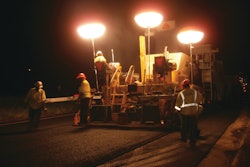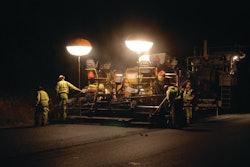FNF Construction Inc., based in Tempe, AZ, has been in business for 20 years. “Our roots really started in asphalt paving,” says Mark Belshe, vice president, asphalt rubber general manager. Today the company ranks among the top 400 contractors in the country and offers diversified services that include excavation, hauling, soil cement, race tracks, structural concrete, utilities, paving, railroads, site development and alternate bidding.
FNF Construction is also a leader in the production and use of asphalt rubber, a product that uses crumb rubber from ground tires in the mix. This product has a long, well-researched history and it was first sought for its engineering properties. “The performance is just head and shoulders above conventional binders,” says Belshe. It is very good at controlling reflective cracking. “It also ages very well because you have much thicker film thicknesses on the stone.”
Despite these engineering benefits, the popularity of asphalt rubber really took off when it was proven to produce a much quieter road surface than conventional asphalt mixes. “That was almost an incidental thing,” recalls Belshe.
“Roads were not paved for noise mitigation, they were paved for performance enhancement.”
But the public has jumped behind this product and really started pushing it because of its noise characteristics. “Now it is a quality of life issue,” Belshe says. Environmentalists also like the product. “It uses used tires, which are tough to get rid of. In any given year, as a company, we probably purchase on the order of 1.5 to 2.3 million tires that are processed into crumb rubber.”
Discovery of a niche
FNF Construction first became involved with asphalt rubber in the late 1980s through work with the Arizona Department of Transportation (ADOT). “We found ourselves being awarded projects where ADOT was specifying the material because they liked what they saw with the performance,” says Belshe.
At the time, the field-blended rubber process was patented. “You had to use a patent holder in order to do the work,” explains Belshe. A specialty subcontractor had to come in and field blend the rubber binder. “Then in the early 1990s, the patent expired. Because FNF Construction had previously studied and understood the process, we geared up to do the work ourselves.”
The business quickly expanded. Competitors soon came to FNF Construction for subquotes on field mixing rubber asphalt. “Over the next four or five years, we ended up buying more equipment for producing asphalt rubber binders,” says Belshe. “About half of the rubber blending business was for ourselves and about half of it was as a subcontractor.”
FNF took advantage of the growing popularity of asphalt rubber in California. “Caltrans used a lot of asphalt rubber mixes,” says Belshe. “FNF found a ready market as an asphalt rubber binder subcontractor.”
Currently, asphalt rubber accounts for 5% to 10% of FNF Construction’s business. The company has six rubber mixing plants, and about half of the asphalt rubber the company produces is still sold to outside contractors.
Mobile strategy is a plus
To be successful with the rubber mixing plants, you need to have the right business model. At FNF Construction, each rubber mix plant has a specific crew that stays with it. “It’s pretty complicated and you need knowledgeable, motivated personnel,” says Jody Sims, business development manager.
These employees have to be very mobile. For instance, Phoenix is a large market for asphalt rubber. ADOT is currently doing Quiet Pavement Phase 3, a program that includes putting a rubber asphalt overlay on the existing pavement to make it quieter. The overlay equates to about 110,000 tons of rubber mix throughout the Phoenix area.
“Even in Phoenix, with as much rubber done here, none of the suppliers of hot mix actually own their own rubber plant,” says Belshe. “The market is not quite big enough to spend every day of the week doing rubber. So the market is a mobile market where a contractor like us that is used to moving stuff around can come in for, say, two weeks, then come back to the hot plant two months later and do another project.”
You cannot have the mindset of fixed plants. “Everything that we own is on wheels,” Belshe states. The classic FNF paving job is probably working on an Interstate away from a metropolitan area. “Because of the length of these types of projects, our crews spend a lot of time away from home. It takes a special type of person. It is constant travel.”
Not just for the Southwest
While asphalt rubber primarily got its start in the Southwest, it can be applied almost anywhere. “A lot of people confuse the constructability issues with the performance issues. Nebraska has an ongoing program, but they pick their season very carefully,” says Belshe. “There is some work being done up around Calgary.” FNF is currently doing a project in British Columbia, and has also provided asphalt rubber in Tennessee, New Mexico, Nevada and the many ranging climates of California.
“But you are not going to go out and do it at 45° F,” cautions Belshe. The binder in asphalt rubber is much thicker and more viscous. “It is more difficult to work with as it cools; it gets stiff. So in the construction phase, you need fairly warm weather. But once it is in place and properly compacted, the performance is outstanding.
“The only thing different for laydown is you do not use a pneumatic roller,” says Belshe. “As far as paving, it is like almost any other modified binder-type product. I have personally worked with polymer modified mixes and I would take rubber any day.”
Belshe admits rubber is more difficult to work with than conventional materials. But it really comes down to heat management. “It is critical that the breakdown roller compact the mix at 290° or 300° F. This is usually right behind the paver,” he notes. “There is less margin for error. If you get behind the curve, you are going to get into trouble. With a conventional mix you can kind of push your way through.”
Asphalt rubber mixes are more expensive than conventional mixes. “For one thing, it has more binder in it,” says Belshe. “That’s the most expensive component. On a unit cost per-ton basis, it is probably 40% to 50% more expensive. But when you look at life-cycle costs, you are talking about something that lasts one and a half to two times longer.”
Reducing Noise at the source
Road noise is attracting more attention these days. For example, Phoenix is beginning to address this issue with its Quiet Pavements program. One attractive solution is asphalt rubber. “ADOT’s mode right now is to put a 1-in. open-graded mix on top of the PCCP,” says Mark Belshe, vice president, asphalt rubber general manager, FNF Construction.
As part of the program, ADOT is taking pre-paving and post-paving noise measurements. “There is a sound consultant that attends all of our weekly meetings so ADOT can stay on top of the schedule,” says Belshe. “They have spent a lot of time on this issue.”
The federal government has been slower to react. “Their sound mitigation program is to put up sound barriers. Instead of dealing with the problem after it is created, we are mitigating it right at the source,” says Belshe. But the Feds are now paying closer attention to asphalt rubber.
A side benefit has been the public’s reaction. Normally, people are upset when you block off lanes of a busy freeway. But the asphalt rubber program in Phoenix has drawn a different response.
“You look at the full closures that are going on around here every weekend and the people are very patient considering how disruptive it is,” says Belshe. “On the SR51, we were paving the Southbound just south of Indian School. There is a pedestrian overpass. It was a Sunday afternoon and there were actually people standing up there applauding.”

















